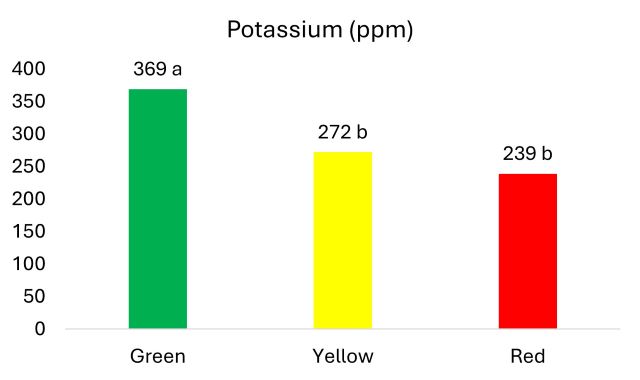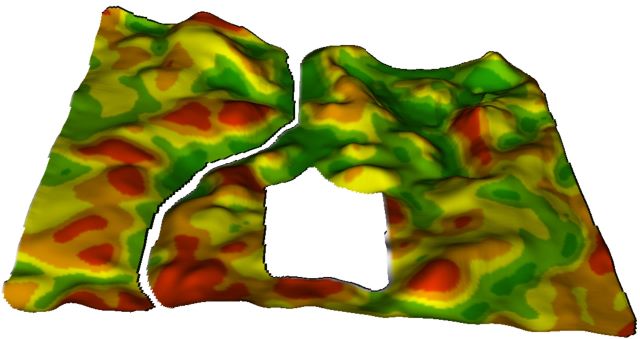Agronomy Update
Dec 16, 2024
Soil Testing: Know Your Dirt!
Soil testing is used widely to guide fertility decisions for the following growing season, but it can also provide some insight into what may have impacted crop productivity in 2024. We have received soil testing results back from 94 fields that were conventionally sampled this fall, and we summarize what we found for organic matter (OM), pH, nitrogen (N), phosphorous (P), and chloride (Cl) below. If you want to compare our results to statewide and regional trends, visit the Agvise website for 2024 soil test summaries. Due to the drought conditions, it was challenging to take a complete soil core to 24 inches. For this reason we are presenting results from the 0-6 inch depth only.Organic Matter
Organic matter is the portion of the soil made up of plant and animal material at different stages of decomposition and typically comprises roughly 1– 6% of the soil. Organic matter enhances soil aggregate formation, rainfall infiltration, and water holding capacity while serving as a nutrient source for soil organisms and crops. Over time, we have lost organic matter in fields through tillage and insufficient carbon being returned to the soil.The graph below shows the percent of fields tested which fell into the different OM categories. The majority of the fields we tested (93%) fell into the “low” category with 1.5 to 3.0 percent organic matter, with an overall average of 2.4%. A few fields (5%) fell into the “moderate” category with 3.1 to 3.4% organic matter and a small percentage fell into the “very low” category with under 1.5% organic matter.

Given the role organic matter plays in holding onto the limited moisture we receive, it may be worthwhile to consider options for building organic matter in fields that have reached these very low levels. We preserve organic matter in agricultural production systems by going to reduced till or no till systems and ensuring we are returning sufficient carbon and nutrition to the soil. Along with adding carbon directly as composted manure, growing high residue crops, perennial crops, or cover crops are all ways that we can increase organic matter in fields that are already in no-till systems. There are some programs available to offset the cost of some of these practices such as a new incentive program for planting cover crops. Increasing organic matter is a slow process that will take many years, so be wary of reading too much into changes in organic matter on soil tests from year to year. As we will discuss below, where samples are taken in a field will also impact these test results.
pH
The pH is a scale which indicates the concentration of hydrogen ions in the soil. The optimal pH for the growth of most crops is between 6 and 7, and this is due to the availability of crop nutrients and the activity of soil microbes. Rhizobia and other bacteria can be negatively impacted below a soil pH of 6, and thus microbial process such as nutrient mineralization and nitrogen fixation can be reduced. Nutrient availability also changes with soil pH, where most of the nutrients needed for crop growth (N, P, K, S, Ca, Mg) are less available when soil pH falls below 5.5. Aluminum is actually more available under acidic soil conditions and this can result in toxicity when the pH is less than 5.
Soils in our area have historically been basic (7.5 to 8.4), but fertilization has decreased the soil pH over time, particularly in the top 0 to 3 inches. Based on a 0-6 inch soil sample, 16% of the fields we tested had a high pH (7.5 to 8.5), 76% of fields were in the moderate range (6.6 to 7.5) and 8% of fields were in the low range (5.6 to 6.5). None of the fields in the low range were below 5.9, however, due to these soil samples being a composite of multiple soil cores, it is possible there are areas within the field that are more acidic. The fields with a pH below 6 could see issues with nutrient deficiency. Herbicide persistence and activity will also be affected by soil pH, so if you don’t normally test your soils it might be a good idea to double check and understand how weed control or crop response could be impacted.

Nitrogen
Of all the crop nutrients, nitrogen is the one we are probably concerned with the most and, with all the potential ways we can lose it, one of the most challenging to get right. With the moisture we experienced last spring, many farmers made the decision to top dress durum to meet the expected increased demand of a higher bushel crop. While we did dry out later in the growing season, that was still a good decision based on the yields many were able to achieve and the levels of nitrogen we detected this fall. In 90% of the fields we tested nitrate levels were below 20 lb./ac which is considered “very low.” Out of the remaining 10%, 9% were in the low category (21 to 40 lb./ac) and only one field was in the moderate category (41 to 60 lb./ac). With so little in the bank, we can expect the crop response to nitrogen fertility next year to be strong. If your soil test fell below 10 lb./ac it is possible that your crop ran out and it was a limiting yield or quality factor for you in 2024.
Phosphorous
Next up on our macronutrients is phosphorous, which due to its immobility in the soil, is a nutrient we can actually bank from year to year. Phosphorous is essential to plant growth as the major component of DNA and ATP, the form of energy plant cells use to fuel reactions including photosynthesis. An adequate supply of phosphorus is needed for proper root development, flowering, seed production and nitrogen fixation in legumes. In 30% of the fields we tested phosphorous levels were high, or very high, while 70% were moderate, low or very low. The 23% of fields that were low or very low are particularly concerning, as that indicates the soil is being mined aggressively for phosphorous.
Banded phosphorous should always be applied when growing wheat, durum and canola because of the “starter” effect, which can be observed even when soil tests detect high levels of phosphorous. Phosphorous doesn’t move in the soil like nitrogen does so placement in the rooting zone is important. In chickpea too, starter can increase seed size and pod height. Pea and lentil are less responsive when soil tests are very high. Soil testing before peas or lentils is therefore of particular importance. If you are considering skipping the starter on those crops, you may limit yield if your soil phosphorus bank is low.
The application of 60 lb. per ac of MicroEssentials S-10 (10-40-0-10) will provide 24 lb./ac P205 which is around the same level as crop removal for a 40 bu./ac durum crop. Canola, lentils and peas will remove about the same amount at this yield. If your soil tests are low to very low, Agvise recommendations are to apply 72 to 85 lb./ac S-10 in durum or wheat, and are even higher for field pea or canola.
Chloride
Chloride is an essential micronutrient for plants and plays an important role in crop water use efficiency, photosynthesis, nitrogen use efficiency and disease resistance. Chloride deficiency has been associated with leaf spotting symptoms, stunting, decreased grain size and yield in durum. Chloride is mobile in the soil, so where it is deficient it should be applied to wheat and durum on an annual basis as potash. Applying potash will also provide potassium, which is also an important nutrient for water use efficiency/drought tolerance.Most of the fields tested this fall were very low to low. Fields in the very low category should apply approximately 25 lbs./ac chloride broadcast or 5 to 10 lb./ac with the seed. Potash is rough 46% chloride so this would be 54 or 10 to 20 lb./ac respectively. Yield increases in response to chloride application of 2 to 5 bu./ac have been observed when soil test values are below 40 lb./ac (medium, low and very low).

Sara Erickson, Agronomist
Dr. Audrey Kalil, Agronomist/Outreach Coordinator
Zone in on Low Productivity Areas
Variable rate fertilizer application alters fertilizer rates based on different productivity areas of your field. The general idea is that low productivity areas won’t produce as much as high productivity areas, so it makes sense to apply less fertilizer there. These areas, or zones, are generally identified using satellite NDVI imagery. NDVI stands for Normalized Difference Vegetation Index, and it uses red and nearinfrared wavelengths of light to measure vegetation density and crop health (greenness). We use a proprietary software to view satellite imagery from multiple growing seasons and from that we can build a zone map for your field. This map guides soil sample collection from high, medium and low productivity areas which are submitted
separately for soil testing. The soil test results then guide the generation of a prescription map. Most of the fields that we zone sampled this fall have been managed using prescription fertilizer applications for several seasons. For that reason some nutrients did not differ by zone including nitrogen, phosphorous, magnesium and micronutrients Cl, Cu, B, Fe, Mn.
Potassium on the other hand tended to be higher on average by around 100 ppm in the green zone compared to the red. Overall potassium levels were high, and only one field had a phosphorous deficiency in the red zone. Zone sampling could be a way to prevent pockets of potassium deficiency in these fields. A similar trend was observed for zinc, where it was moderate to high (1 ppm) in the green areas and low in the yellow and red areas (0.6 to 0.7 ppm).

Organic matter was highest in the green areas, followed by yellow and then red. Many red areas correspond with hill tops, and the reduced organic matter is likely a result of erosion. Given the role organic matter plays in water holding capacity and nutrient cycling, this probably a contributing factor for reduced yield in the yellow/red areas.


Prescription maps and zone testing is still a fairly new practice in our geography. As it becomes more widely adopted we will have more information and understand better how soil characteristics are affecting productivity within fields.
Sara Erickson, Agronomist
Dr. Audrey Kalil, Agronomist/Outreach Coordinator
Winter Fertilizer Bookings
Welcome to winter! It is hard to believe that this would be a busy time of year for the Agronomy Division, but the last couple weeks of the year along with the first couple weeks of January are actually really busy for us with both inventory and end of the year prepays.Historically, you will usually save money on crop nutrients when purchasing them either in the fall or even at the end of the year. I could safely say that this will be true about 80% of the time, if not even more. More importantly, buying or booking your tons at this time of the year will guarantee that you will have the tons when you need them. There was a push for building larger fertilizer plants almost 20 years ago to replace the 1,000 ton plants built 50 years ago. This was in order to be able to store more tons and have access to unit trains of fertilizer to resupply our system in a hurry when needed. Our growers use such a huge amount of fertilizer in such a short time, that storage, logistics and timing our purchases have become almost more important than the price of the products. Fertilizer will usually follow commodity prices, so regardless of the price per bushel or price per ton of the nutrients, it will still be the best investment you can make and will return more money than any other input or investment in your farming operation.
One of the biggest benefits of being able to store large amounts of dry fertilizer for our growers is that this gives them the ability to buy in the winter and have it stored for free until they need it in the spring. Storing dry fertilizer in hopper tanks on farm is almost like a game of Russian roulette. You will have fertilizer set up in these bins at some point and I have seen a lot of hopper tanks destroyed when trying to empty dry fertilizer that was set up in them from storing fertilizer for an extended time.
We can store about 40% of our spring urea in our plants, so we will continue to buy tons through the winter months and the closer we get to the spring application season, the more chance of higher prices. This is driven mainly by supply and demand along with logistics. When everyone needs tons at one time, the freight can get really expensive and more undependable than any other time of year. Chances are, the sooner you buy or book your nitrogen for spring, the better chance you will have of making sure you will get the tons when needed and will probably save some money over the in-season prices.
Phosphate fertilizer is even more important this year due to supply issues that started in late fall after two hurricanes affected about 500,000 tons of phosphate production in Florida. Our suppliers were already on allocation before the first hurricane, so if the suppliers do not get caught up on production by spring, phosphate fertilizers will continue to be tight. My information sources have warned me that producers will not be caught up until the second half of 2025, so that means that tons will more than likely be tight through spring. The US continues to put tariffs on producers in Morocco, China and Russia and that is keeping a lot of import tons out of the US so we will continue to see prices where they have been for the past few years and supply issues will more than likely continue while the tariffs are still high. We have a very good working relationship with Mosaic and have already placed a 90-car unit train of MicroEssentials S-10 into Williston, but will also depend on getting additional spring cars in May when available.
We have a lot of customers that continue to do end-of-year purchasing for tax purposes, but even more are taking advantage of our storage and will do purchasing on whichever side of the new year is most advantageous to them. We also offer un-paid booking contracts for our customers who are only looking to lock up their spring tons and want to pay for it with our normal terms. There is an additional cost for this to help pay the 6 months of interest on our money, but in most cases will be less than normal operating notes. Keep in mind, tons are limited since we do source a lot more tons in the spring than we can store, so if you want to take advantage of winter prices and storage, stop by your Agronomy location today!
Thank you for your business this past year and I wish you all a very Merry Christmas and a Happy New Year and look forward to helping you make your farming operation successful in 2025.
John Salvevold, Agronomy Division Manager, CCA